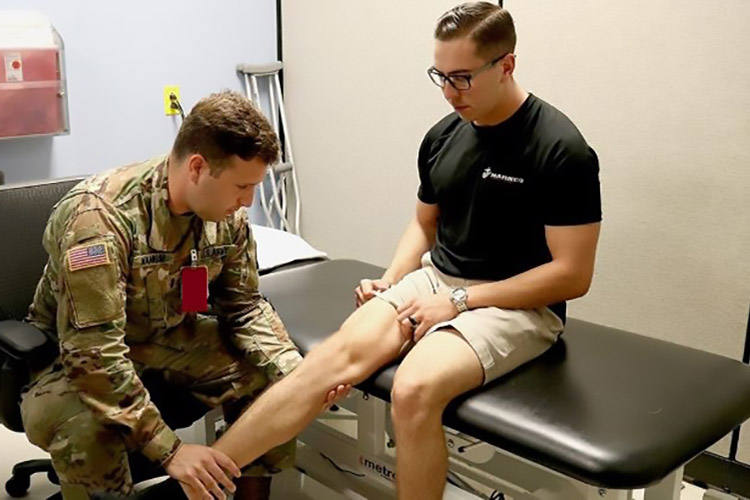Surveillance snapshot: Illness and injury burdens, reserve component, U.S. Armed Forces, 2021
 Army 1st Lt. Nicholas Wankum, a physical therapist at Madigan Army Medical Center, evaluated the progress Marine Staff Sgt. Dalton Everhart made in his range of motion since the recruiter came to the emergency department after an injury nearly a month before this September 2019 visit (U.S. Army photo).
Army 1st Lt. Nicholas Wankum, a physical therapist at Madigan Army Medical Center, evaluated the progress Marine Staff Sgt. Dalton Everhart made in his range of motion since the recruiter came to the emergency department after an injury nearly a month before this September 2019 visit (U.S. Army photo).
You also may be interested in...
Article
Dec 1, 2023
The proportions of women and Hispanic service members increased from 2018 to 2022, while the proportions of non-Hispanic White active component service members and those under 20 years of age decreased.
Article
Dec 1, 2023
This data analysis identified a small number of reported chikungunya cases, and even fewer hospitalizations, suggesting that risk of chikungunya virus disease to U.S. service member readiness is small.
Article
Dec 1, 2023
Compared to civilians, active component service members may have increased risk of SLE due to greater exposure to environmental risk factors such as silica dust and ultraviolet radiation, and higher rates of post-traumatic stress disorder, which have been linked to SLE.
Article
Dec 1, 2023
The Medical Surveillance Monthly Report (MSMR) shares the news of the recent death of our colleague, Valerie Williams.
Article
Dec 1, 2023
Command decisions for balancing risks have differed in every pandemic of the past century because those decisions occurred in a broader cultural context of acceptable health risks tied to available technology and scientific knowledge.
Article
Nov 1, 2023
Reportable Medical Events are documented in the Disease Reporting System internet by health care providers and public health officials throughout the MHS.
Article
Nov 1, 2023
Continuous surveillance is essential to prevent cold weather injuries and mitigate their adverse impacts on military operations.
Article
Nov 1, 2023
Common respiratory viruses are associated with substantial morbidity within the MHS.
Article
Nov 1, 2023
This report describes recent frequencies and rates of clinically-diagnosed sunburn among active component service members of the U.S. Armed Forces.
Article
Nov 1, 2023
The U.S. Advisory Committee on Immunization Practices recommends influenza vaccination for all health care personnel, including MHS staff, to protect both themselves and their patients.
Article
Oct 1, 2023
The emergence of mutant P. falciparum parasites in many malaria-endemic areas has led to false-negative results in all HRP2-detecting rapid diagnostic tests, undermining their critical utility, especially in deployment settings.
Article
Oct 1, 2023
Complete and timely reporting of notifiable medical conditions among the Department of Defense (DOD) beneficiary population is important for the control of communicable and preventable diseases and injuries.
Article
Oct 1, 2023
This report describes the incidence rate of colorectal cancer among active component U.S. military service members between 2010 and 2022.
Article
Oct 1, 2023
Reportable Medical Events are documented in the Disease Reporting System internet by health care providers and public health officials throughout the Military Health System.
Article
Sep 1, 2023
Reportable Medical Events are documented in the Disease Reporting System internet by Military Health System providers and public health officials to monitor, control, and prevent the occurrence and spread of diseases of public health interest or readiness importance.
You are leaving Health.mil
The appearance of hyperlinks does not constitute endorsement by the Department of Defense of non-U.S. Government sites or the information, products, or services contained therein. Although the Defense Health Agency may or may not use these sites as additional distribution channels for Department of Defense information, it does not exercise editorial control over all of the information that you may find at these locations. Such links are provided consistent with the stated purpose of this website.
You are leaving Health.mil
View the external links disclaimer.
Last Updated: July 11, 2023